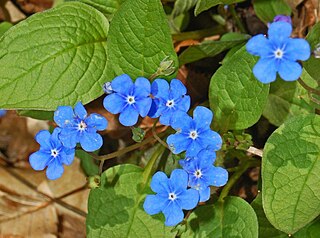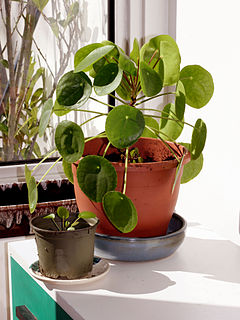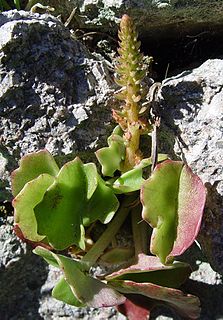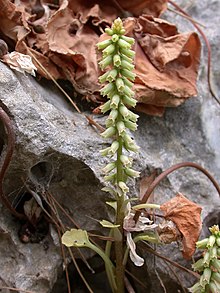
Umbilicus rupestris, the navelwort, penny-pies or wall pennywort, is a fleshy, perennial, edible flowering plant in the stonecrop family Crassulaceae in the genus Umbilicus so named for its umbilicate (navel-like) leaves.
A storage organ is a part of a plant specifically modified for storage of energy (generally in the form of carbohydrates) or water. Storage organs often grow underground, where they are better protected from attack by herbivores. Plants that have an underground storage organ are called geophytes in the Raunkiær plant life-form classification system. Storage organs often, but not always, act as perennating organs which enable plants to survive adverse conditions.

Umbilicus is a genus of over ninety species of flowering plants in the family Crassulaceae. Many of its species have been given synonyms under different genera such as Rosularia, Cotyledon, and Chiastophyllum. However, those that remain in Umbilicus are listed below:

Pennywort is a common name given to several different plants around the world. In general they have round leaves and a low-growing habit. Pennywort may refer to:

Gonialoe variegata, also known as tiger aloe and partridge-breasted aloe, is a species of flowering plant in the family Asphodelaceae. It is an evergreen succulent perennial indigenous to South Africa and Namibia. It is common in cultivation.
Umbilicus chrysanthus, known as Venus' navel or nabelkraut, is a succulent, perennial flowering plant in the family Crassulaceae, in the genus Umbilicus, which is found in the Alps. It is called Venusnabel in German, but the French translation nombril de Vénus refers to navelwort.

Omphalodes verna, the creeping navelwort or blue-eyed-Mary, is a rhizomatous herbaceous perennial plant in the genus Omphalodes belonging to the family Boraginaceae.

Cotyledon is one of some 35 genera of succulent plants in the family Crassulaceae. Mostly from Southern Africa, they also occur throughout the drier parts of Africa as far north as the Arabian Peninsula. Ten of its species are mostly confined to South Africa, where unlike Tylecodon, they occur commonly in both the winter and summer rainfall regions. They may be found on coastal flats and rocky hillsides, or as cremnophytes on cliff faces. Their decussate, evergreen leaves are very variable in shape, even within some species, but the flowers are, apart from colour, very similar.

Pilea peperomioides, the Chinese money plant, ufo plant, pancake plant or missionary plant, is a species of flowering plant in the nettle family Urticaceae, native to Yunnan and Sichuan provinces in southern China.

Dendrobium kingianum, commonly known as the pink rock orchid, is a flowering plant in the orchid family Orchidaceae and is endemic to eastern Australia. It usually grows on rocks, rarely as an epiphyte, and has thin, spreading leaves and spikes of up to fifteen, usually pink flowers in late winter to spring. It is popular in Australian native horticulture and is a commonly cultivated orchid among Australian orchid species growers.

Umbilicus horizontalis, the horizontal navelwort, is a fleshy perennial flowering plant in the family Crassulaceae native to the Mediterranean Basin and Middle East, from the Azores in the west to Oman in the east in rocky habitats.

Umbilicus oppositifolius, common names lamb's-tail and gold drop, is a succulent, perennial flowering plant, a species in the genus Umbilicus of the family Crassulaceae. It is endemic to shady mountain areas in the Caucasus.

Hydrocotyle vulgaris, the marsh pennywort, common pennywort, water naval, money plant, lucky plant or copper coin, is a small creeping aquatic perennial plant native to North Africa, Europe, the Caucasus and parts of the Levant.

In botany, succulent plants, also known as succulents, are plants with parts that are thickened, fleshy, and engorged, usually to retain water in arid climates or soil conditions. It is a characteristic that is not used scientifically for the definition of most families and genera of plants because it often can be used as an accurate characteristic only at the single species level. The word succulent comes from the Latin word sucus, meaning 'juice', or 'sap'. Succulent plants may store water in various structures, such as leaves and stems. The water content of some succulent organs can get up to 90–95%. Some definitions also include roots, thus geophytes that survive unfavorable periods by dying back to underground storage organs may be regarded as succulents. In horticultural use, the term succulent is sometimes used in a way that excludes plants that botanists would regard as succulents, such as cacti. Succulents are often grown as ornamental plants because of their striking and unusual appearance, as well as their ability to thrive with relatively minimal care.

Adenanthos obovatus, commonly known as basket flower, or, jugflower, is a shrub of the plant family Proteaceae endemic to Southwest Australia. Described by French naturalist Jacques Labillardière in 1805, it had first been collected by Archibald Menzies in 1791. Within the genus Adenanthos, it lies in the section Eurylaema and is most closely related to A. barbiger. A. obovatus has hybridized with A. detmoldii to produce the hybrid A. × pamela. Several common names allude to the prominent red flowers of the species. It grows as a many-stemmed spreading bush up to 1 m (3.3 ft) high, and about 1.5 m (4.9 ft) across, with fine bright green foliage. Made up of single red flowers, the inflorescences appear from April to December, and peak in spring.

Adenanthos barbiger, the hairy jugflower or hairy glandflower, is a species of shrub in the family Proteaceae. It is endemic to the south-west of Western Australia. It usually grows to 1 metre high, and has bright red flowers that appear mostly between August and December. The species was first formally described in 1839 by English botanist John Lindley in A sketch of the vegetation of the Swan River colony.

Boucerosia frerei is a plant in the genus Boucerosia which contains several species many of which are native to the Indian sub-continent and one species Boucerosia crenulata, native to Myanmar. B. frerei, is a small succulent endemic to the forest area in the Western Ghats and Deccan plateau in Maharashtra state in India. It is also grown as a greenhouse plant by succulent plant enthusiasts. At one time, it was on the IUCN list of twelve most endangered species on earth, but conservation efforts have brought it back from the brink of extinction.

Umbilicus schmidtii is a flowering plant in the family Crassulaceae. The species is endemic to Cape Verde. It is listed as endangered by the IUCN.

Leaf window, also known as epidermal window, and fenestration. is a specialized leaf structure consisting of a translucent area through which light can enter the interior surfaces of the leaf where photosynthesis can occur. The translucent structure may include epidermal tissue, and in some succulent plants it consists of several cell layers of parenchyma, which may also function as water-storage tissue. It can appear as a large continuous patch, a variegated or reticulated region, or as numerous small spots. Is found in some succulent plants native to arid climates, allowing much of the plant to remain beneath the soil surface where it is protected from desiccation by winds and heat while optimizing light absorption. Many species featuring leaf windows are native to Southern Africa.

















